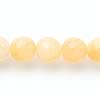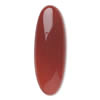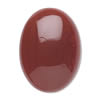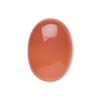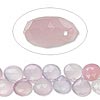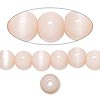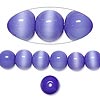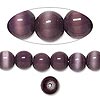Agate
Mix Agate
Moss Agate
Tree Agate
Summary:Wondering how those colored striking bands that sometimes even resemble the dendrites of a tree, are formed? Agate’s chemical composition is Silicon Dioxide, SIO2. It is a fossil stone and is formed when gas bubbles trapped in solidifying lava are filled with alkali and silica water.
About agate / An introduction to agate
Ever strolled by a jewelry store window and been absolutely fascinated by a creatively striped semiprecious stone? Well, that's agate for you. Pronounced as /ag'-it/ it is a semiprecious stone composed of layers of quartz of different colors. Etymology traces the roots of the word back to the Latin word 'Achates', so called because it was found along the Sicilian river of Achates, now the river Drillo. Even now it is a major source of the stone. Agate is a chalcedony quartz that forms in concentric layers in varied colors. The bands or stripes which could resemble eyes or scallops or even some kind of vegetal growth, are formed in an extended process. Each agate is found as a round nodule, filling a hollow cavity in a host rock. Chalcedony quartz is not formed out of one single crystal but of finely ground micro crystals. So the striking color bands are due to the slight variations and the grain sizes of these crystals. Other quartz gems include the purplish Amethyst, and the citrus yellow Citrine.
How agate is formed
Wondering how those colored striking bands that sometimes even resemble the dendrites of a tree, are formed? Agate's chemical composition is Silicon Dioxide, SIO2. It is a fossil stone and is formed when gas bubbles trapped in solidifying lava are filled with alkali and silica water. These bubbles and the silica congeal into a gel. The alkali attacks the iron in the surrounding lava, resulting in the loss of water. Bands of iron hydroxide are formed in the gel. The gel, losing water crystallizes. When cut in cross sections an agate can reveal some spectacular forms.
Types of agate
The peculiarities and the dissimilarities in the shape and color of these bands characterize the varieties of agate. Onyx, a magnificent, magical quartz with black, brown or red stripes on white is also an agate. It is called a Riband Agate. A Ring Agate has concentric bands of different colors giving the appearance of an eye[s] when seen. The Moss Agate is another fascinating form formed by filaments of a green color embedded in the agate. This often looks like a vegetal growth and hence known as Moss Agate.
The incredible variety of agate/ Sheer variety/ A stunning array of colors and forms
Agate occurs in an illimitable amount of colors and patterns. This contributes to its phenomenal, singular beauty and universal popularity. There are hundreds of agate variants coined with special variety names. Sometimes they are named after where they are found, for instance the Lake Superior Agate or the Brazilian Agate and sometimes they are named after the colors of the crystalline bands, for instance the Brown Zebra Stone Agate, so named for its zebra stripes of brown. This fascinating agate is found in Africa. Frog Skin Agate/ Jasper is the exact green of a frog's skin. Probably the prettiest agate is the Neapolitan Ice Cream Agate; a white agate alternatively banded with pink and red stripes. The Blue Lace Agate is also one of the most popular agates with its charming, blue lacy, wavy pattern on white. Grape Agate is found in the form of light purplish grape shaped nodules in a host rock. Plume Agate is a rare agate and as the name suggests, Plume Agate has feather like inclusions embedded in the stone. Leopard Skin Agate, a singularly striking stone, when polished, resembles the black edged rosettes of a leopard's coat. Another fascinating agate is the Turitella Agate which has bits of fossils of Turitella [a snail] in it. Crazy Lace Agate, Lizard Skin Agate, Fairburn Agate, French Agate and Carnelian agate or other common agates. But these are only a few and there are literally hundreds of agates. Every year new ones turn up and new names are coined.
History of agate
Discovered by Stone Age Man, agate was highly prized by antediluvian civilizations. But the agate working industry blossomed and flourished in the Idar-Oberstein district of Germany where it was found in abundant deposits.
Decorative and functional / Ornamental and practical
Its durability and property of being easy to fashion made early man use it in both practical and ornamental forms. Agate was crafted into weapons [axes] and stoneware [bowls], even furniture and of course jewelry. In fact collecting agate was a fashion among European royalty during the Renaissance period and museums across Europe exhibit some fine pieces. Due to its highly decorative and striking colors, it was used in 'Commesso'- a Florentine mosaic which is a technique of making pictures with wafer-thin, cut-to-shape pieces of colorful iridescent semiprecious stones. Commesso was an art form of 16th century Florence.
Facts and Properties
Despite its high hardness rating among gemstones of 6.5-7.0, it is not a very hard stone. It will chip and crack fairly easily. As with all gems, safeguard your agate from sharp blows and scratches. Avoid contact with household chemicals. It is non porous but the texture is greasy and is opaque. But they take to polish easily. In fact, agate's natural colors are enhanced by polishing. Agate has strong metaphysical properties. It is known to combat stress and alleviate worry. These stones are strongly believed to have protective, stabilizing and comforting properties. Legend and ancient superstition has it that wearing agate made a person agreeable, happy, cautious yet brave. Ancient cultures used it as a talisman as it was believed to bestow on the wearer, protection against all dangers. It is also believed to have a major significance in pagan cultures and Hindu astrology. Persian magicians used agate to avert storms. White agate was apparently a cure for insomnia and guaranteed pleasant dreams. So with its spectacular colors and forms, wide distribution and strong metaphysical properties, agate receives universal acclaim
Agate Folklore, Legend & Healing Properties:
Agates have been traditionally believed to possess healing and supportive qualities. They also have been believed to enhance intuitiveness and insight,Agate is one of the oldest stones in recorded history. Agates attract strength. It also protects from stress and energy drains. When you are very sad, the agate will let you know that this will pass and help you get on to another better day.



